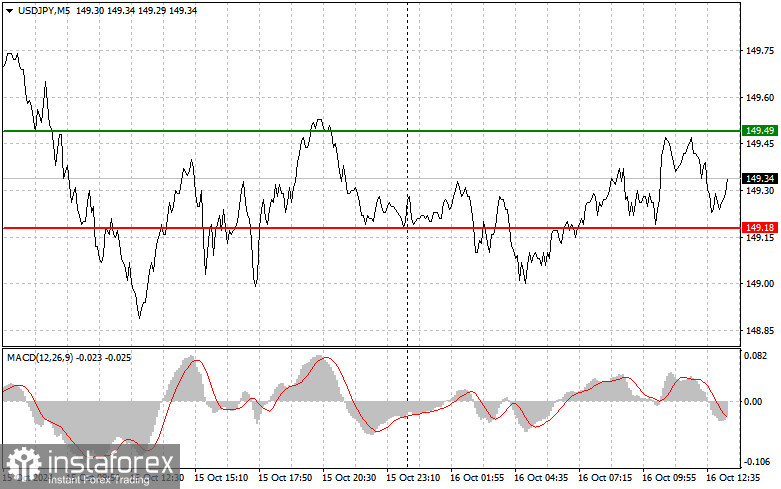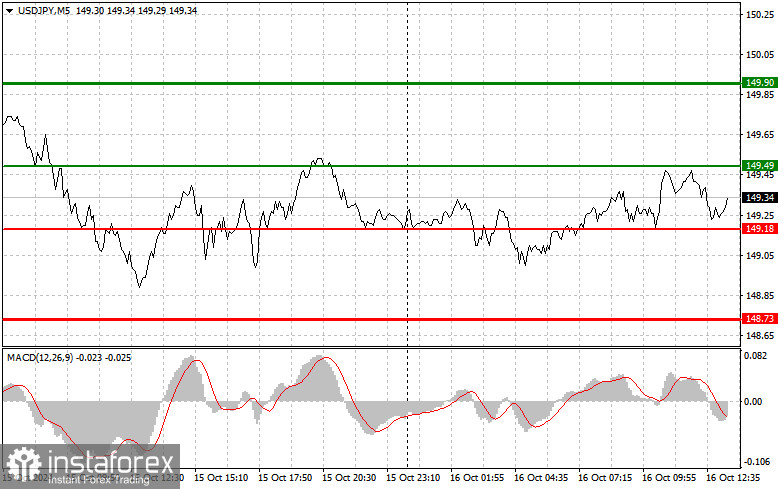Analysis of Trades and Tips for Trading the Japanese Yen
Due to extremely low market volatility for the USD/JPY pair, the anticipated price tests did not occur, so the desired entry points were not reached. This pattern may repeat in the second half of the day, as the U.S. Import Price Index is the only data release, which is unlikely to drive dollar growth. Previously, statements from Federal Reserve officials supported the dollar, but today there are none, so trading volumes will likely remain low. For my intraday strategy, I plan to implement Scenarios #1 and #2.

Buy Signal
Scenario #1: Today, I plan to buy USD/JPY at the entry point around 149.49 (green line on the chart), aiming for a rise to the 149.90 level (thicker green line on the chart). At 149.90, I will close my buy trades and open sell positions, targeting a 30-35 point move in the opposite direction. A rise in the pair today is likely only within the current channel. Note: Before buying, ensure the MACD indicator is above the zero line and just starting to rise from it.
Scenario #2: I also plan to buy USD/JPY today if the price tests the 149.18 level twice consecutively, with the MACD indicator in the oversold area. This will curb the pair's downward potential and likely lead to an upward reversal. A rise towards the resistance levels of 149.49 and 149.90 can be expected.
Sell Signal
Scenario #1: I plan to sell USD/JPY if it breaks below 149.18 (red line on the chart), which would lead to a quick decline in the pair. The key target for sellers will be 148.73, where I will exit sales and immediately buy in the opposite direction, expecting a 20-25 point move from this level. Selling pressure will return if the pair fails to hold above the daily high. Note: Before selling, ensure the MACD indicator is below the zero line and just starting to fall from it.
Scenario #2: I also plan to sell USD/JPY today if the price tests the 149.49 level twice consecutively, with the MACD indicator in the overbought area. This will curb the pair's upward potential and likely trigger a downward reversal. A decline towards the support levels of 149.18 and 148.73 can be expected.

What's on the Chart:
- Thin green line – the entry price where you can buy the trading instrument.
- Thick green line – the expected price where you can place Take Profit or lock in profits manually, as further growth beyond this level is unlikely.
- Thin red line – the entry price where you can sell the trading instrument.
- Thick red line – the expected price where you can place Take Profit or lock in profits manually, as further declines beyond this level are unlikely.
- MACD Indicator: When entering the market, it is important to consider overbought and oversold zones.
Important: Beginner traders in the Forex market must be very cautious when deciding to enter the market. Before the release of important fundamental reports, it is best to stay out of the market to avoid sharp price fluctuations. When trading during news releases, always set stop-loss orders to minimize losses. Without stop-losses, one can quickly lose their entire deposit, especially when trading large volumes without proper money management.
Remember, successful trading requires a clear trading plan, like the one outlined above. Spontaneous trading decisions based on the current market situation are generally a losing strategy for intraday traders.





















